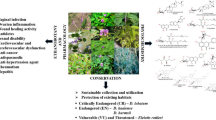Abstract
Medicinal plants have been used for centuries to fight against all types of diseases, essentially certain types of cancer. In this study, we investigate the potential of Moricandia arvensis chloroform root extract (ChlR) as anticancer agent by evaluating its effect on viable cell number, oxidation, the sensitivity of cancer cells to apoptosis and melanin biosynthesis. ChlR extract decreased the proliferation of Caco-2 and BE cell lines by 99.60 and 95.21%, respectively. Furthermore, the extract exhibited significant inhibitory activity (99.43%) against calpain after 2 h of incubation with Caco-2 cells, suggesting its possible use as an anticancer agent. ChlR also enhanced significant antioxidant activity (IP = 100%) after 2 h of incubation with the two colorectal cancer cell lines and a significant inhibition of melanin synthesis. Targeting calpain using ChlR extract could be an interesting way to prevent and/or treat colorectal cancers; in addition, this extract might be used as a skin whitening agent.








Similar content being viewed by others
References
Arora-Kuruganti P, Lucchesi PA, Wurster RD (1999) Proliferation of cultured human astrocytoma cells in response to an oxidant and antioxidant. J Neurooncol 44:213–221
Braham H, Mighri E, Ben jannet H, Matthew S, Abreu PM (2005) Antioxidant phenolic glycosides from Moricandia arvensis. J Nat Prod 68:517–522
Evan GI, Vousden KH (2001) Proliferation, cell cycle and apoptosis in cancer. Nature 411:342–348
Fimognari C, Hrelia P (2007) Sulforaphane as a promising molecule for fighting cancer. Mutat Res 635:90–104
Guixin C, Enyuan Z, Su YL (2009) The study on the whitening effects of traditional Chinese medicines. J Soc Cosmet Sci Korea 35:257–263
Hou DX (2003) Potential mechanisms of cancer chemoprevention by anthocyanins. Curr Mol Med 3:149–159
Je Ma C, Jung WJ, Lee KY, Kim YC, Sung SH (2009) Calpain inhibitory flavonoids isolated from Orostachys japonicus. J Enzyme Inhib Med Chem 24:676–679
Juge N, Mithena RF, Trakaa M (2007) Molecular basis for chemoprevention by sulforaphane: a comprehensive review. Cell Mol Life Sci 64:1105–1127
Kuntz S, Wenzel U, Daniel H (1999) Comparative analysis of the effects of flavonoids on proliferation, cytotoxicity, and apoptosis in human colon cancer cell lines. Eur J Nutr 38:133–142
Leloup L, Wells A (2011) Calpains as potential anti-cancer targets. Expert Opin Ther Targets 15:309–323
Matés JM, Sanchez-Jimenez FM (2000) Role of oxygen species in apoptosis: implications for cancer therapy. Int J Biochem Cell Biol 32:157–170
Moongkarndi P, Kosem N, Kaslungka S, Luanratana O, Pongpan N, Neungton N (2004) Antiproliferation, antioxidation and induction of apoptosis by Garcinia mangostana (mangosteen) on SKBR3 human breast cancer cell line. J Ethnopharmacol 90:161–166
Olsson ME, Gustavsson KE, Andersson S, Nilsson A, Duan RD (2004) Inhibition of cancer cell proliferation in vitro by fruit and berry extracts and correlations with antioxidant levels. J Agric Food Chem 52:7264–7271
Roh JS, Han JY, Kim JH, Hwang JK (2004) Inhibitory effects of active compounds isolated from safflower (Carthamus tinctorius L.) seeds for melanogenesis. Biol Pharm Bull 27:1976–1978
Shen Y, Chiou W, Chou Y, Chen CF (2003) Mechanisms in mediating the anti-infammatory effects of baicalin and baicalein in human leukocytes. Eur J Pharmacol 465:171–181
Siegrist W, Eberle AN (1986) In situ melanin assay for MSH using mouse B16 melanoma cells in culture. Anal Biochem 159:191–197
Skandrani I, Boubaker J, Bouhlel I, Limem I, Ghedira K, Chekir-Ghedira L (2010) Leaf and root extracts of Moricandia arvensis protect against DNA damage in human lymphoblast cell K562 and enhance antioxidant activity. Environ Toxicol Pharmacol 30:61–67
Surh YJ (1999) Molecular mechanisms of chemopreventive effects of selected dietary and medicinal phenolic substances. Mutat Res 428:305–327
Villaño D, Fernández-Pachón MS, Troncoso AM, García-Parrilla MC (2004) The antioxidant activity of wines determined by the ABTS·+ method: influence of sample dilution and time. Talanta 64:501–509
Acknowledgements
We acknowledge Campus France and Ministry of Higher Education, Scientific Research and Technology, Tunisia for the financial support of this study (Action Intégrée de Coopération Inter universitaire Franco-Tunisienne).
Funding
Funding was provided by Campus France (EGIDE; 784339J).
Author information
Authors and Affiliations
Corresponding author
Rights and permissions
About this article
Cite this article
Skandrani, I., Leloup, L., Kovacic, H. et al. Moricandia arvensis Chloroform Root Extract Reduces Calpain Activity, ROS Production in Colorectal Cancer Cells and Melanin Biosynthesis. Iran J Sci Technol Trans Sci 43, 747–753 (2019). https://doi.org/10.1007/s40995-018-0597-6
Received:
Accepted:
Published:
Issue Date:
DOI: https://doi.org/10.1007/s40995-018-0597-6




